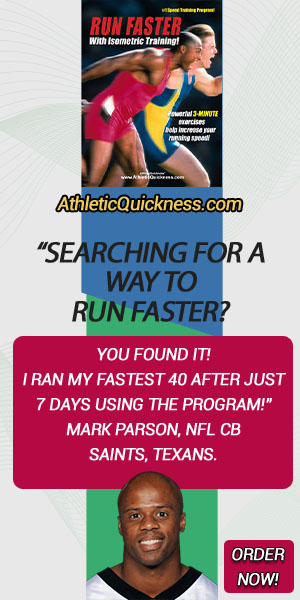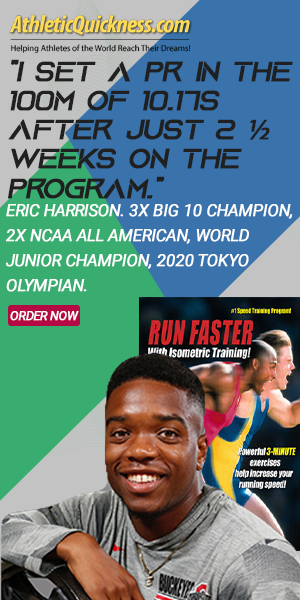If you are looking for a surefire way to increase your running speed immediately then look no further than the muscles involved in the running motion that pull you forward instead of push you forward.
If you haven’t read through the material on the running motion, then now would be a good time to get acquainted with the information contained in it. In that article, it was pointed out that of the three phases, only one of the phases actually involved muscles that push you while running and the other two phases involved muscles that pull you.
However, nearly everyone focuses on leg exercises that push the body forward and practically no one does any exercises for the leg muscles that pull you. This means there is a huge upside to your ability to increase your running speed, if only you knew how.
Popular exercises like the back squat, front squat, power clean, and clean/pulls provide sufficient exercise for both the hip extensors (glutes and hamstrings) and knee extensors (quadriceps). And while these are foundational types of exercises to do, they only affect the pushing motion of running.
But your running stride is one of the other two phases that is anything but a pushing motion. It is entirely a pulling-type motion involving your hip flexor muscles. The other pulling motion occurs within your hip extensor muscles after your stride is completed and we will focus on them in another article.
There are 7 of these hip flexor muscles located on both sides of your body for a total of 14. If you recall, their names are the Psoas, Iliacus, Sartorius, Rectus Femoris, Pectineus, Adductor Brevis and Adductor Longus. Their main goal is to flex (pull) the thigh up on the pelvis. See Figure A.

Some people may refer to these muscles as thigh flexors instead of hip flexors since it’s much easier to observe the movement of the entire thigh taking place at the hip than it is to try and figure out what the hip joint itself is doing.
The amount of distance you take with each running cycle is dependent not just on how hard you can push against the ground with your hip extensors, knee extensors and ankle plantar-flexors, but also on how fast and far you can accelerate and reach out with your other leg that is off the ground. This is where your hip flexor muscles come in to play. See Figure B.

Again, this is anything but a pushing motion where your thigh flexor muscles have to pull, not push, the weight of the entire leg forward and then upward. The amount of additional horsepower, or manpower, that can be created with just a little extra work on this muscle group is enormous. The amount of speed you can acquire is close to unbelievable.
You would be hard-pressed to name a few exercises that you actually do on a consistent basis that effectively targets these muscles the way you need to for speed. Sure, sit-ups and perhaps hanging leg lifts might engage these muscles a little, but neither of these exercises takes advantage of the tremendous leverage that can be applied to them by the length of your entire leg. And in case you are wondering, your body weight alone is not sufficient to force a peak muscle contraction either with these exercises.
The following exercise will show you how to activate these muscles for peak contraction force, i.e., fast muscle speed. At first glance, it may appear easy to do, but nothing could be further from the truth as you will soon discover. Follow the instructions in the exercise set-up as well as the training schedule included below and be prepared to be amazed at just how fast you will get in such a very short time.
Note: Consult with your physician before attempting this exercise.
EXERCISE #1
STEP 1. Tie one of your bands around an immovable object, in this case the leg of a heavy table, (e.g. a pole), as shown in Figure 1-1a. Next, place your right foot inside the loop with your back facing the pole as shown in Figure 1-1b.

STEP 2. Depending upon your size and strength, begin stepping slowly away from the pole or other immovable object in the direction of the black arrow as shown until you feel the tension in your right hip flexors and quadriceps (white arrows) starting to increase. See Figure 1-1c.

STEP 3. Lift your right foot off the ground about 12 inches as shown in Figure 1-1d. Finally, extend your right foot forward in the direction of the black arrow as shown in Figure 1-1e and then hold this position without changing it for 10-15 seconds using between 70-80% of your maximum strength.

STEP 4. Repeat STEPS 1-3 with your left leg.
Repeat this process two more times giving you a total of three ‘reps’ for the right leg and three for the left as shown in Table 1 below:

Training Tips.
1) This exercise is meant to be physically challenging. If you find that your initial attempt with it is too easy, then you will need to increase the resistance by either adding in a second band, using a stronger band and/or repositioning yourself further away from where your band is attached to stretch it further.
2) The best way to know if you are using the proper amount of effort (70-80% of your maximum strength for 10-15 seconds) is you should feel as though you need to take a rest from the exercise around the 10 second mark. If you can hold the final position as shown in Figure 1-1e for a lot longer than 15 seconds, then you do not have enough resistance.
3) Make sure you have something stable to balance against while doing this exercise. You don’t want to be moving all over the place but instead, you want to remain as steady as possible to really target your hip flexors.
4) Be careful not to stretch the band past its limit where there is no more stretch left in it. If you do, you will essentially turn the band into a static rope, or cable, and limit its effectiveness.

STEP 1. Record your fastest time in one or more of the following races before starting Exercise #1 in the spaces below:

STEP 2. Perform Exercise #1 as outlined in Table 1 three times a week for two weeks. Preferably do the exercise on Monday, Wednesday and Friday. As listed, this will only take you 3 minutes a day to complete, 9 minutes per week and only 18 minutes for the two weeks.
STEP 3. Allow 2 days of rest after your last workout session and re-time yourself in the same races below:

Now imagine how much faster you will be if you do the whole program?



